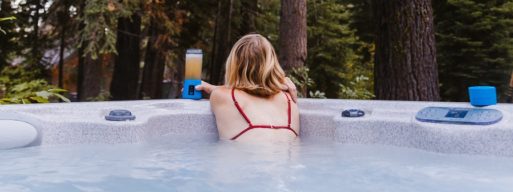How to Lower Running Costs for a Hot Tub This Winter
One of the joys of having a hot tub at home is the ability to use it year-round, especially on cold winter nights under a blanket of stars.
But despite only using your hot tub sporadically throughout the cooler seasons, there’s still a risk of racking up a hefty hydro bill and wasting a ton of water.
So, to help you save on the costs of running your hot tub this winter, here are some tips for making your hot tub more efficient to conserve energy, water, and chemicals, and protect it from costly damage.
Avoid Expensive Energy Bills
Several factors affect a hot tub’s energy consumption, including whether a hot tub has an efficient pump and filtration system, a quality cover, and good insulation.
Most hot tubs also have an economy mode to help reduce energy costs. And running your hot tub filtering cycles during off-peak hours will also help reduce energy costs.
Keep in mind that some hot tubs have unnecessary features that will increase your energy consumption.
Costs to Consider
Running costs for a hot tub include:
- Electricity for running the hot tub, including the heater, pumps, lights, and all other components
- Water for refilling the hot tub
- Chemicals
- Maintenance, servicing, and repairs
Reducing Running Costs
While hot tub operating costs are unavoidable, there are ways to reduce these costs.
Here are tips to help you reduce running costs for a hot tub:
A Well-Insulated Cover
Since heat rises, about 60 percent of the heat in a hot tub is lost through the surface of the water. Along with losing heat, a hot tub also loses water through evaporation and chemicals.
But with a well-insulated fitted cover, you can keep most of that heat, water, and chemicals in when your hot tub is not in use. You can save more on heating costs since your hot tub will maintain its temperature, and your heater won’t have to work harder to keep your hot tub warm in winter.
You can also save more on water and chemical costs since you won’t lose water to evaporation and have to refill and treat your hot tub water as often.
If your hot tub cover is old, consider replacing it since hot tub covers can wear out over time, leading to heat loss, especially if the cover is waterlogged.
Turn Off your Air Valves
The air valves and jets add cool air to the hot tub, which lowers the water temperature. This means you end up paying more for energy to heat the water. So, make sure to turn these off when your hot tub is not in use.
Hot Tub Temperature Setup
Keeping your hot tub set at a consistent temperature at all times is more energy-efficient and cost-effective than lowering the temperature when not in use. If you lower the temperature when not in use, more energy will be used to raise the temperature from cool to warm, especially in winter.
But if you keep the hot tub at a consistent temperature, it won’t take time and energy to heat up, and it will be ready to use any time you’d like. Plus, you won’t have to worry about freeze damage if the outside temperature drops.
Maintenance and Servicing
Hot tub maintenance and servicing are necessary for keeping your hot tub running efficiently. So make sure to test the water regularly, keep the water balanced, and clean the hot tub and filters to ensure efficient water flow.
Drain the water and clean the hot tub and filters every three months. Use a hot tub cleaner to clean the shell and pillows. Clean the filters with a non-foaming filter cleaner, and replace the filter every one to two years.
And if you notice any issues with your hot tub, don’t put off calling a hot tub pro for an inspection and repairs. A simple parts repair or replacement can end up saving you more in the long run in both running costs and by avoiding more costly repairs.
For example, if your hot tub has a leak, it will cause problems such as water loss and the spray foam insulation to become waterlogged and lose its insulating effectiveness. If you don’t repair the leak, you’ll need to keep refilling your hot tub—which will cost you more for water and chemicals. And your hot tub heater will need to work harder to heat the new water and maintain the temperature without proper insulation.
The Takeaway
Running a hot tub during the colder months doesn’t have to cost a fortune. With these tips, you can make your hot tub more efficient, cut down operating costs, and save money year-round, especially when enjoying your hot tub winter.


